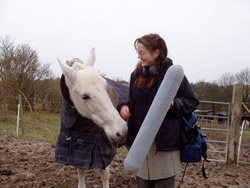- 16 December 2008
New research shows how horses recognise their neighbours

Straight from the horse's mouth: Leanne Proops and subject.
A new study into how horses recognise members of the same herd suggests that it's not just humans who use complex memory processes to identify each other.
University of Sussex mammal communication researchers studied the reaction of horses to the sight of one member of the same herd while they heard the call of either the same horse, or a different herd member.
They found that the horses showed a stronger reaction to the 'incongruent' calls that didn't match the herd member they had just seen compared with the congruent calls.
The results, published in Proceedings of the National Academy of Sciences of the United States of America on December 15, 2008, suggest that horses, like humans, use a 'cross modal' system for recognising each other - one that involves a combination of sensory cues such as auditory and visual/olfactory information.
Lead author, doctoral student Leanne Proops, whose thesis is on social cognition in horses, says: "Individual recognition within species is a complex process and is very poorly understood. We know that in humans it is cross-modal. For example, we recognise someone by how they look and how they sound. It now appears that horses, and perhaps other animals, also possess a cross-modal representation of known individuals."
The study, by Leanne Proops, her DPhil supervisor Dr Karen McComb and mammal communication researcher Dr David Reby, focussed on 24 horses at Woodingdean livery yard in Sussex and Sussex Horse Rescue Trust. Subjects watched a herd member being led past them before the individual went out of view and a call from that or a different associate was played from a loudspeaker positioned close to the point of disappearance. The researchers measured how long the test horse looked in the direction of the loudspeaker. They found that horses responded more quickly and looked for longer in the direction of the incongruent calls (which didn't match the horse they had seen) compared to the congruent calls, indicating that the mismatched combination violated their expectations.
Leanne Proops says: "Given that the stimulus horse was out of sight when the vocal cue was heard, it is likely that the test horse was accessing or activating some form of multimodal memory of that individual's characteristics."
Dr McComb, from the University's Centre for Mammal Vocal Communication Research in the Department of Psychology, says: "Our experimental design could provide a powerful way to study the cognitive abilities underlying individual recognition in a wide range of species."
Notes for editors
- 'Cross modal individual recognition in domestic horses (Equus caballus)' by Leanne Proops, Karen McComb and David Reby, is published by Proceedings of the National Academy of Sciences of the United States of America, on 15 December, 2008
- For more information, contact the University of Sussex Press Office, Jacqui Bealing and Maggie Clune, Tel: 01273 678888, email: press@sussex.ac.uk